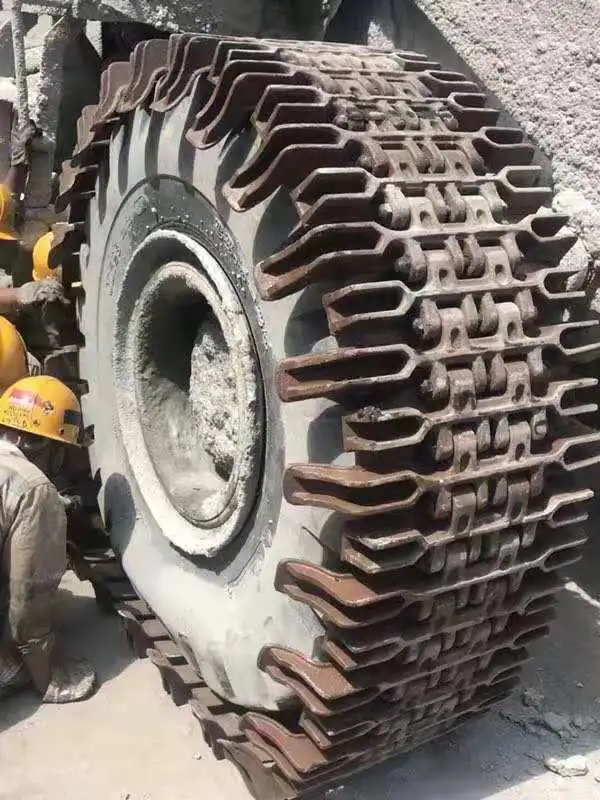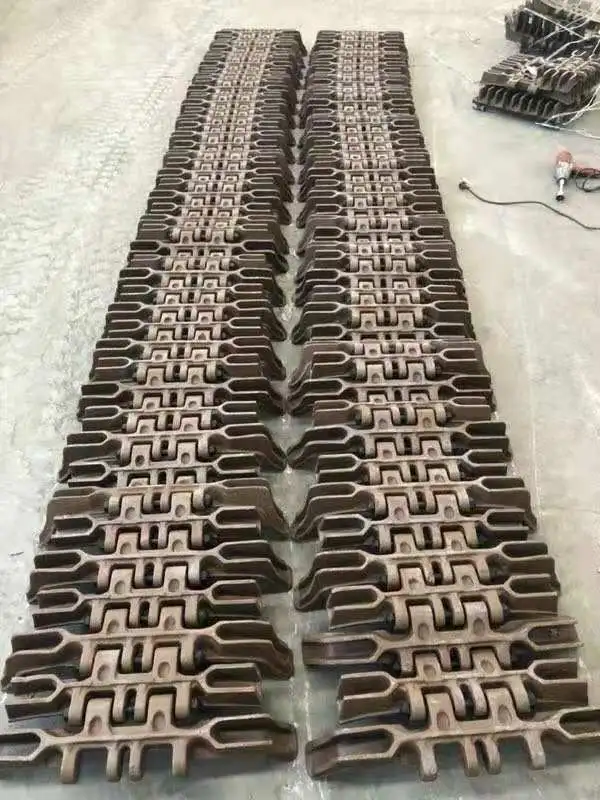How to choose tire chains?
Choosing the right loader tire protection chain is crucial for maximizing equipment performance and safety in challenging terrains. These specialized chains enhance traction, protect tires from damage, and significantly extend their lifespan. When selecting tire chains, consider factors such as tire size, equipment compatibility, working conditions, and load capacity. By carefully evaluating these aspects, you'll ensure optimal protection for your loader tires, improved efficiency, and reduced maintenance costs across various industries including construction, mining, and forestry.
Basic Compatibility
Matching tire size for optimal loader protection
The first step in choosing the right loader tire protection chain is ensuring a perfect match with your tire size. Accurate measurements are essential for proper fitment and performance. Start by checking your tire's sidewall for the size designation, typically expressed as width-aspect ratio-rim diameter (e.g., 23.5-25). It's crucial to select chains that correspond precisely to these dimensions.
Remember, an ill-fitting chain can cause damage to both the tire and the equipment. Too loose, and it may slip off during operation, potentially causing accidents. Too tight, and it could put excessive stress on the tire, leading to premature wear or even blowouts. Many manufacturers provide sizing charts or online tools to help you find the right fit. When in doubt, consult with a tire specialist or the chain manufacturer to ensure you're making the correct choice.
Verify chain type compatibility with your equipment
Once you've determined the correct size, it's important to verify that the chain type is compatible with your specific loader model. Different equipment designs may have varying requirements or limitations when it comes to tire chains. Some loaders might need specific chain patterns or attachment methods to function properly and safely.
Check your loader's manual for any recommendations or restrictions regarding tire chain use. Pay attention to factors such as clearance requirements, maximum chain thickness, and any potential interference with the vehicle's components. Some modern loaders come with built-in chain compatibility features, making selection easier. If you're unsure, reach out to your equipment dealer or the chain manufacturer for guidance on compatibility issues.
Consider clearance between tire and vehicle body
Adequate clearance between the tire and the vehicle body is crucial when selecting loader tire snow chains. Insufficient space can lead to the chains rubbing against the loader's body or components, causing damage and potentially compromising safety. Measure the gap between the tire's outer edge and the closest part of the vehicle body, including fenders, suspension components, and brake lines.
Most chain manufacturers specify the additional space required for their products. As a general rule, you should have at least 2 inches (5 cm) of clearance on all sides when the chains are installed. Remember that this clearance may change as the vehicle moves and the suspension compresses. If clearance is tight, consider low-profile chains or alternative traction devices designed for limited-clearance applications. Always prioritize safety and proper fitment over attempting to use chains in situations where there's insufficient space.

Choose Based "Working Terrain"
Selecting chains for muddy construction sites
When working on muddy construction sites, the right tire chain can make a world of difference in your loader's performance. For these slippery conditions, look for chains with aggressive tread patterns and wide-spaced links. These features help the chains dig into the mud, providing better traction and preventing your loader from getting bogged down.
Consider chains with a diamond pattern or studded design, as these offer excellent grip in soft, wet soil. Some manufacturers offer specialized mud chains with self-cleaning properties, which prevent mud from clogging the links and reducing effectiveness. Remember, while aggressive chains provide better traction, they may also cause more surface disturbance. If minimizing ground impact is a concern, balance traction needs with site preservation requirements.
Best chain options for snow and ice conditions
For loaders operating in snowy or icy environments, choosing the right chain is critical for safety and efficiency. Look for chains specifically designed for winter conditions, often featuring a tighter link pattern to provide maximum contact with slippery surfaces. V-bar chains are particularly effective on ice, with their sharp edges biting into frozen surfaces for superior grip.
In deep snow, consider chains with tall treads or even double-link designs that can plow through heavy accumulations. Some chains combine different link types, offering a balance of performance on both snow and ice. For areas with frequent freeze-thaw cycles, opt for chains made from materials resistant to rust and corrosion. Remember, while chains enhance traction, they're not a substitute for careful operation in hazardous winter conditions.
Chains for rocky terrain in mining applications
Mining operations often involve navigating rocky, abrasive terrains that can quickly wear down standard tires and chains. For these challenging environments, choose heavy-duty chains designed to withstand extreme wear and impact. Look for chains made from hardened alloy steel or featuring reinforced links that can resist crushing and breaking under the weight of large loaders.
Chains with a block pattern often perform well in rocky conditions, providing good traction while distributing the load to prevent individual links from taking too much stress. Some manufacturers offer chains with replaceable wear pads or protectors, allowing for easier maintenance and extended chain life. In quarry environments where rock cuts are a concern, consider chains with side protection features to guard the tire sidewalls against sharp edges.

Durability And Load Capacity
Assessing chain material for heavy-duty applications
The material composition of loader tire protection chains plays a crucial role in their durability and performance, especially in heavy-duty applications. High-quality chains are typically made from alloy steel, known for its exceptional strength-to-weight ratio and resistance to wear. For extreme conditions, some manufacturers use specialized alloys or heat-treated steel to further enhance durability.
When assessing chain materials, look for options that offer a balance of hardness and toughness. Hardness contributes to wear resistance, while toughness prevents brittle fractures under impact. Some chains feature a case-hardened surface with a softer core, combining wear resistance with flexibility. For corrosive environments, consider chains with protective coatings or made from corrosion-resistant alloys. Remember, while stronger materials often come at a higher initial cost, they can significantly reduce long-term expenses through extended service life and reduced downtime.
Load ratings: Matching chains to your equipment's capacity
Selecting chains with the appropriate load rating is critical for both safety and performance. Each chain set has a specific load capacity, which must match or exceed your loader's gross vehicle weight rating (GVWR) when fully loaded. Undersized chains may fail under stress, potentially causing equipment damage or accidents.
To determine the correct load rating, consider your loader's maximum operating weight, including any attachments or typical payload. It's always better to choose chains with a higher load rating than strictly necessary to account for occasional overloading or particularly harsh operating conditions. Many manufacturers provide load rating charts or online calculators to help you select the right chain based on your equipment specifications. Don't forget to factor in dynamic loads, which can be significantly higher than static loads during operation, especially when working on uneven terrain or making sudden movements.
Longevity factors: Wear resistance and maintenance needs
The longevity of loader tire protection chains depends on various factors, including material quality, design, and maintenance practices. Chains with hardened wear surfaces and reinforced link designs typically offer superior wear resistance. Some manufacturers use special alloys or surface treatments to enhance durability in specific environments, such as highly abrasive or corrosive conditions.
Regular maintenance is key to maximizing chain life. Look for designs that facilitate easy inspection and repair, such as those with replaceable wear components. Some chains feature rotation indicators, helping operators know when to rotate the chains for even wear. Consider the ease of tensioning and adjustment, as proper tension is crucial for performance and longevity. While low-maintenance chains may have a higher upfront cost, they can offer significant savings over time through reduced downtime and replacement frequency. Establish a regular inspection and maintenance schedule based on the manufacturer's recommendations and your specific operating conditions to ensure optimal performance and longevity of your loader tire protection chains.

Choosing the right loader tire protection chain is a critical decision that impacts equipment performance, safety, and operational costs. By carefully considering factors such as basic compatibility, working terrain, and durability requirements, you can select chains that provide optimal protection and traction for your specific needs. Remember to prioritize quality and proper fit over initial cost savings, as the right chains can significantly extend tire life and improve overall efficiency. Regular maintenance and proper use will ensure you get the most value from your investment in loader tire protection chains.
FAQ
1. How often should I replace my loader tire protection chains?
The replacement frequency depends on usage intensity and conditions. Generally, inspect chains regularly and replace when wear exceeds 50% of the original link thickness or if there's significant damage. In harsh conditions, this might be every 500-1000 operating hours.
2. Can I use the same chains for different terrains?
While some chains are designed for multiple terrains, it's best to use chains specifically designed for your primary operating conditions. Universal chains may offer compromised performance compared to terrain-specific options.
3. How do I properly tension my loader tire chains?
Proper tensioning varies by chain type and manufacturer. Generally, chains should be snug but not overly tight. Follow the manufacturer's guidelines and use any provided tensioning tools. Re-check tension after the first hour of use and periodically thereafter.
4. Are there alternatives to traditional tire chains for loader protection?
Yes, alternatives include tire studs, track systems, and special traction tires. However, chains often provide the best balance of traction, protection, and cost-effectiveness for most loader applications.
5. How do loader tire protection chains affect fuel efficiency?
Chains can slightly increase fuel consumption due to added weight and rolling resistance. However, the improved traction often leads to more efficient operation, potentially offsetting the fuel impact. Choose lightweight chain designs for minimal fuel efficiency impact.
Loader Tire Protection Chain Manufacturer
Tiannuo Machinery specializes in manufacturing high-quality loader tire protection chains designed to meet the diverse needs of industries such as railway construction, mining, forestry, and heavy construction. Our product line extends beyond tire chains to include a wide range of equipment for railway maintenance, excavator modifications, and engineering accessories. With a focus on innovation and quality, we offer solutions that enhance equipment performance and longevity.
Our tire protection chains are engineered to triple tire lifespan while improving traction and efficiency. Features include quick installation, low failure rates, and minimal maintenance requirements. We offer various models to suit different loader sizes and operating conditions. For example, our 23.5-25 model, designed for 50-ton loaders, boasts a robust construction with 35CrMo main plates and 45# carbon steel side plates, making it ideal for challenging environments like mines, quarries, and tunnels.
At Tiannuo Machinery, we understand the importance of reliable equipment in maintaining operational efficiency. That's why we're committed to providing not just products, but comprehensive solutions tailored to your specific needs. For more information about our protection chains or other equipment, contact us at arm@stnd-machinery.com. Our team is ready to help you find the perfect solution for your operational challenges.
References
- TianNuo Machinery Official Website
- Construction Equipment Magazine: Tire Chain Guide
- Mining Safety: Proper Use of Tire Chains
- Forestry Equipment Journal: Choosing the Right Chains
- Transportation Industry Standards for Tire Chains
- Vermeer Equipment Specifications and Safety Features
About Author: Arm
Arm is a leading expert in the field of specialized construction and railway maintenance equipment, working at Tiannuo Company.

